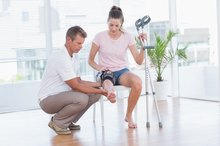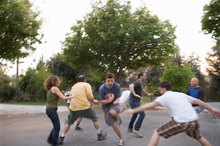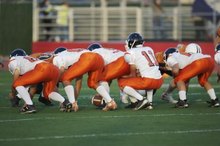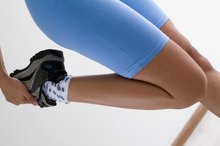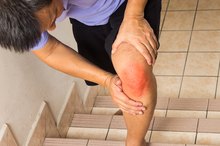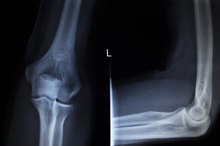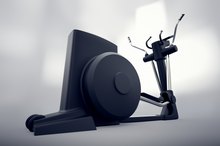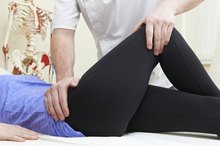What does fact checked mean?
At Healthfully, we strive to deliver objective content that is accurate and up-to-date. Our team periodically reviews articles in order to ensure content quality. The sources cited below consist of evidence from peer-reviewed journals, prominent medical organizations, academic associations, and government data.
- “Canadian Family Physician”; Preventing Running Injuries: A Practical Approach For Family Doctors; C. A. M. Johnston, M.D., et al.; September 2003
- “Canadian Family Physician”; Preventing Running Injuries: A Practical Approach For Family Doctors; C. A. M. Johnston, M.D., et al.; September 2003
- “Journal of Athletic Training”; The Meniscus: Review of Basic Principles With Application to Surgery and Rehabilitation; Timothy Brindle, et al.; 2001
- “Journal of Athletic Training”; The Meniscus: Review of Basic Principles With Application to Surgery and Rehabilitation; Timothy Brindle, et al.; 2001
The information contained on this site is for informational purposes only, and should not be used as a substitute for the advice of a professional health care provider. Please check with the appropriate physician regarding health questions and concerns. Although we strive to deliver accurate and up-to-date information, no guarantee to that effect is made.
Knee Injuries & Sprinting
Sprinting requires a lot of power output from your leg muscles and places a tremendous amount of force on your knees. Strain on your leg muscles and knees combined with the sudden changes in direction and abrupt stops in sports creates a potential for knee injuries. These injuries include muscle strains, meniscus tears and knee sprains 3. Consult your health professional about preventing and treating knee injuries associated with sprinting in sports.
If you are experiencing serious medical symptoms, seek emergency treatment immediately.
Knee Injuries
Common knee injuries among athletes include meniscus tears and knee sprains. A meniscus tear is a tear of the cartilage located between the bones of your knee. A knee sprain is when one or more of the ligaments around your knee becomes stretched or torn. The muscles around your knee, particularly your hamstrings, are also susceptible to tearing. Symptoms associated with knee injuries include swelling, pain, joint stiffness, muscle weakness and joint instability.
- Common knee injuries among athletes include meniscus tears and knee sprains.
- A knee sprain is when one or more of the ligaments around your knee becomes stretched or torn.
Sprinting
Exercises for a Torn Quad
Learn More
Sprinting requires powerful muscle contractions from your hamstrings and quadriceps muscles, which can result in a muscle tear and pull on your knee joint. A sudden stop or change in direction while sprinting in sports, such as football and basketball, can cause a meniscus tear or knee sprain. A 2003 research article published in journal “Canadian Family Physician” also reports that weak and inflexible muscles of your thigh and calf can greatly increase your risk of injury, including knee injuries.
Treatment
To reduce your symptoms and promote healing, avoid painful activities, ice the affected area and wear a compression wrap. Take anti-inflammatory drugs and elevate your leg if swelling persists. Discuss with your physician other treatment options, such as a knee brace, physical therapy and surgery. For severe injuries, it may take four to 12 weeks before you can return to sprinting and normal activities.
- To reduce your symptoms and promote healing, avoid painful activities, ice the affected area and wear a compression wrap.
- Take anti-inflammatory drugs and elevate your leg if swelling persists.
Prevention
How to Care for a Bruised Knee
Learn More
When you return to sprinting and other activities, your physician may advise you to temporarily wear a knee brace to reduce your risk of reinjury. Additionally, wear supportive shoes that provide adequate cushion; these can help maintain proper knee alignment and act as a shock absorber while sprinting. Orthotics may also be necessary if you have flat feet or high arches. Furthermore, perform a warmup and stretch before sprinting to maintain proper flexibility. Perform strength exercises, such as single-leg hops and lunges, to strengthen your leg muscles and protect your knees. Lastly, to prevent overexertion and reinjury of your knee and surrounding muscles, increase your running speed and distance slowly, focusing on one or the other at a time.
- When you return to sprinting and other activities, your physician may advise you to temporarily wear a knee brace to reduce your risk of reinjury.
Related Articles
References
- “Canadian Family Physician”; Preventing Running Injuries: A Practical Approach For Family Doctors; C. A. M. Johnston, M.D., et al.; September 2003
- “Journal of Orthopaedic & Sports Physical Therapy”; Strength Deficits Identified With Concentric Action of the Hip Extensors and Eccentric Action of the Hamstrings Predispose to Hamstring Injury in Elite Sprinters; Yusaku Sugiura, M.S., et al.; August 2008
- American Academy of Orthopaedic Surgeons; Muscle Strains in the Thigh; August 2007
- “Journal of Athletic Training”; The Meniscus: Review of Basic Principles With Application to Surgery and Rehabilitation; Timothy Brindle, et al.; 2001
- Summit Medical Group; Knee Sprain; Pierre Rouzier, M.D.
- Meniscus Tears. American Academy of Orthopaedic Surgeons. https://orthoinfo.aaos.org/en/diseases--conditions/meniscus-tears.
- Torn Meniscus. Mayo Clinic. https://www.mayoclinic.org/diseases-conditions/torn-meniscus/symptoms-causes/syc-20354818.
Writer Bio
Since 2007 Hannah Mich has written e-newsletters and been published in the "Missouri Journal of Health, Physical Education, Recreation and Dance." She has a Bachelor of Science in exercise science from Truman State University and a Master of Education in applied kinesiology from the University of Minnesota.

